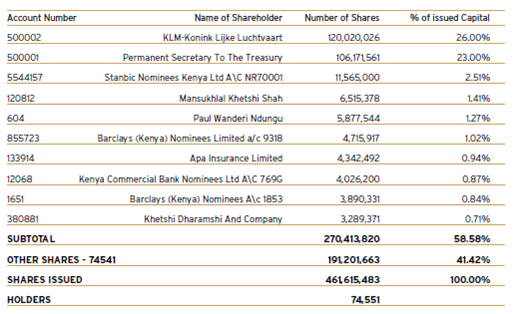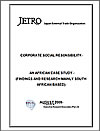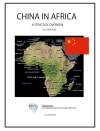 Kenya Airways
Kenya Airways
All data are collected in the Fiscal Year of 2008-2009.
Company Profile and History
Kenya Airways is the flag carrier airline of Kenya, based in Nairobi. It started operations on 4 February 1977, and operates scheduled services throughout Africa and to Europe and the Indian subcontinent, with its main base at Jomo Kenyatta International Airport (JKIA), Nairobi.
The airline was established after the break-up of the first East African Community and the consequent demise of East African Airways and was wholly owned by the Kenyan government until April 1996.
In 1996, shares were floated to the public, and the airline started trading on the Nairobi Stock Exchange. In October 2004, the company cross-listed its shares on the Dar-es-Salaam Stock Exchange. In April 2004, the company re-introduced Kenya Airways Cargo as a brand and in July 2004, the company's domestic subsidiary Flamingo Airlines was re-absorbed.
In March 2006, Kenya Airways won the 'African Airline of the Year' Award for 2005, for the fifth time in seven years. On September 4, 2007, SkyTeam, the second-largest airline alliance in the world, welcomed Kenya Airways as one of the first official SkyTeam Associate Airlines. In 2008 it won the Company of the Year award for strategic planning and emergency preparedness, as well as Manager of the Year to Director Paul Kasimu. Travel News & Lifestyle Magazine voted Kenya Airways as African Airline of Choice, Best Regional Airline, Flying Blue voted the best Frequent Flier program and Msafiri - Best in-flight magazine.
Kenya Airways Fleet:
Boeing 737-300 (4) - Short haul regional routes; Boeing 737-700 (4) - Short haul regional routes; Boeing 737-800 (5) - Short haul regional routes; Boeing 767-300ER (5) - Long haul international and intercontinental routes; Boeing 777-200ER (4) -Long haul intercontinental routes; Boeing 787-8 (9 orders) - Long haul international and intercontinental routes; Embraer 170LR (3) - Lease.
In 2005 Kenya Airways achieved IOSA (IATA Operational Safety Audit) becoming the 1st carrier in sub-Saharan to get this rigorous safety certification.
It has code sharing agreements with: KLM; Air France; Precision Air (private Tanzanian airline); Northwest Airlines (United States); Kenya Airways and Rwanda Air code share on the Kigali-Nairobi-Kigali route; and Kenya Airways and Korean Air code share on the Nairobi - Seoul route.
In Country Location
Headquarters and Base: Airport North Road, Embakasi, Nairobi, Kenya, Tel: + 254-(0)20-6422000
Services and Products
The group's principal activity is providing international, regional and domestic carriage of passengers and cargo by air. It also provides ground handling services to other airlines and the handling of import and export cargo. The group operates domestic flights and flies to 42 destinations in Africa, Middle East, Asia and Europe. At 31 March 2008, the group had 24 aircraft in operation, either owned or on operating leases.
Number of Employees
4,267 employees
Financial Information

Market Share
It currently has a 54% share of scheduled capacity at Nairobi airport and is sub-Saharan Africa’s third- biggest airline.
Business Objective
"To consistently be a Safe & Profitable Airline that guarantees World Class standards in service delivery, product quality and operational performance; to be the Airline of choice in Africa; and to develop JKIA as a premier hub in Africa."
Business Model
Given a highly competitive environment, Kenya Airways sees its information gathering capacity, analysis and interpretation of the global environment as key to facilitate faster and correct business decision-making. This way, Kenya Airways hopes to enhance ability for rapid response to opportunities, threats and challenges in the market place. It further continues to focus on profitable expansion of its network through a combination of direct access and alliances with other carriers. Sustainable improvement in yield will be pursued through a combination of a new revenue management system and better discipline. Management also places emphasis on greater productivity, costs restraints and reduction in wastage; the implementation of various systems for improved operational management, maintenance, planning and control and the development of its people to better equip them to face these challenges.
Kenya Airways has embarked on an extensive project to upgrade and refresh its brand. This project includes all customer touch points with the objective of bringing a fresh contemporary feel to the entire traveller’s experience. Kenya Airways awarded the project to Johannesburg-based branding specialists, BLACK Brand, Strategy & Design. The project commissioned in March 2008 should be complete by the end of the financial year 2009/10.
Ownership of Business
The airline is owned by individual Kenyan shareholders (30.94%), KLM (now Air France-KLM) (26%), Kenyan government (23%), Kenyan institutional investors (14.2%), foreign institutional investors (4.47%) and individual foreign investors (1.39%).
Top shareholders

Benefits Offered and Relations with Government
Kenya Airways, through the Government of Kenya, continues to conclude Bilateral Air Services Agreements, with recent examples being Cote d’Ivoire, Burundi, Mauritius, Libya, Tunisia, Bangladesh, Sri Lanka, South Korea and Malaysia.
Transit visas for West African passengers in Nairobi have been an impediment to growth. Other challenges include lack of market access due to restrictive bilateral regimes, bureaucracy and continued double-taxation on revenues in Kenya and some countries in Africa. The company is working very closely with the Government to address these issues and to move expeditiously and conclude Avoidance of Double Taxation Agreements.
From its inception in 1977 until 1995, the airline had ten different government-appointed chief executives. Therefore, each successive holder of the office had insufficient time to develop and implement effective strategies. Moreover, because the board of directors consisted mainly of political appointees with no specific experience either in managing a business, in general, or an airline in particular, the airline lacked clear strategic direction.
By 1991, Kenya Airways was unable to pay its debts, which had run into millions of U.S. dollars. Hence, the government continually had to bail the company out of bankruptcy by paying its foreign loans (which the government had guaranteed). In fact, by 1992, the airline was technically bankrupt, and, hence, the government was searching for a way to improve Kenya Airways’ messy balance sheet and bring it to profitability. This was achieved by commercialization and privatization.
The government dismissed the airline’s entire board of directors, together with the chief executive, and appointed a new board with Phillip Ndegwa as executive chairman and David Narmu as chief general manager. In choosing Ndegwa and Narmu, the government was, from a technical and political viewpoint, choosing the best and ablest people in the country to manage the company. They both had impressive backgrounds and experience in the private and public sectors.
In January 1996, the government sold 26% of its shareholding to KLM for US$26 million. Following the agreement with KLM, the government sold the bulk of its shares on the Nairobi Stock Exchange and retained a minority stake in Kenya Airways.
Product Development
The airline continues to expand, with one more Embraer 170 regional jet and three B737-800’s delivered in 2008/2009. There will be a significant delay in the delivery of the nine B787s, originally due for delivery in 2010 to 2012.
New innovations on the website include a more user friendly booking system, online check-in and a new integrated payment solution which allows passengers to make payments for bookings using their credit cards.
Improvements from investments in the airline’s IT network, especially in Kenya, have continued. These have been in the form of improved tools and more redundancy to reduce system unavailability. Improvements made in the JKIA IT systems include: replacement of old check-in equipment in Unit 3 with more modern equipment; reduction of exposure to frequent power cuts at JKIA; building of more redundancy into connecting to host reservations and check-in systems in Europe; deployment of the Automated Boarding Control technology at JKIA boarding gates which automatically transfers information contained on the magnetic stripe on a boarding pass directly into the departure control system at the boarding gates; and deployment of Flight Information Display Screens (FIDS) at JKIA.
Kenya Airways signed a deal with the Seychelles Tourism Board (STB) that will see the two countries market tourism through a twin destination concept. STB in collaboration with the Kenya Tourism Board (KTB) and their respective travel agents will market the two countries as a package. This will, for example, see tourists offered Kenya's Safari experience and the Seychelles island beaches as a package. The airline plans to ride on the concept by carrying passengers in transit from other destinations to Mahe, the Seychelles, and vice versa. The move comes only months after Kenya Airways signed a deal with KTB and other Kenyan sectors such as hoteliers and the media to grow arrivals from African countries to boost tourism and increase the airline's revenues.




